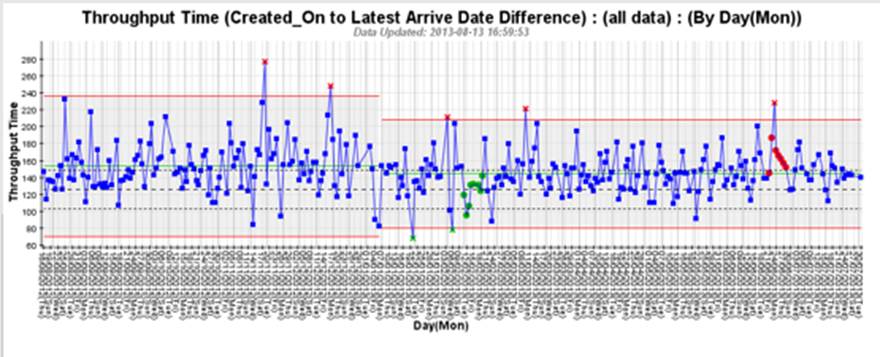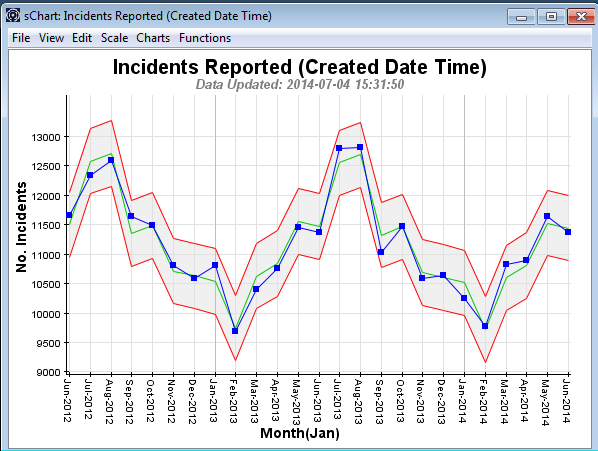Forecasting – Prediction is very difficult, especially if it’s about the future!
10/07/2017


Niels Bohr, the Nobel laureate in Physics and father of the atomic model, is quoted as saying, “Prediction is very difficult, especially if it’s about the future!” This quote serves as a warning of the importance of testing a forecasting model out-of-sample. It’s often easy to find a model that fits the past data well — perhaps too well! — but quite another matter to find a model that correctly identifies those features of the past data which will be replicated in the future.
So here’s the thing: in the private and public sector, we keep hearing senior executives talking about being more predictive — getting on the front-foot and being less reactive. Almost all of them fail to recognise that unless your business processes, their incoming demand and outgoing outcomes are not “In Control” (meaning in statistical control) then forecasting is worthless — a black art at best! Here’s an example of a process that is not In Control:

The above processes (there are 2 of them, with a change near the middle of the chart causing a “process break” between the first part of the process and the second part of the process) are not In Control. The chart has a large number of different types of signals, red x indicating unusually long delivery times, green x indicating unusually short delivery times, green • indicating sustained unusually short delivery times and red • indicating sustained unusually long delivery times. Using this data to forecast forwards will produce at best a range of between 80 and 200 (lower and upper red performance corridor guidelines on right part of chart), but because it’s not In Control, there will be occasions when these guidelines will be exceeded. This is because, as Niels Bohr says, the signals indicate that the process contains features that may or may not be replicated in the future.
Looking at a process that is In control:

We can see that there are no signals and that the data is following a very strong seasonal pattern. This means the results are likely to be dominated by features of the past that will be replicated in the future. So we can confidently (but not with absolute certainty — there’s always risk, but in this case it is minimised by being In Control) predict what will happen in the future (unless we or the system we are examining make changes):

Thus, we can be pretty sure that the forecast for February 2015 will be around an average (green line bounded by upper and lower red guidelines) of 9,750+500 approx., and for July 2015 will be around an average of 12,500+500 approx.
BUT, if a senior executive says, “I need you to be more precise, I need one number”, you’re up against another well-respected Physicist — Heisenberg and his Uncertainty Principle. The more precise one thing you measure, the fuzzier another becomes. So asking for a forecast which is a single number only (without a range of possible values), means that the probability of it actually occurring approaches zero! Or as Dilbert says, worthless!
Categories & Tags:
Leave a comment on this post:
You might also like…
Automotive Engineering: From student to hypercar innovation at Rimac
We sat down with recent graduate Thomas Perrin, to discuss how his year on the MSc in Automotive Engineering at Cranfield University propelled him from the lecture hall directly into the ...
What this year at Cranfield really meant to me
Every Cranfield journey is unique. In this alumni reflection, Zachea Scicluna shares what her year at Cranfield truly meant, from facing uncertainty to gaining hands-on experience in industry-backed projects. I’ve been reflecting (and delaying) ...
Preparing for assignments and exams?
Sorry! We know it seems a bit mean to mention the exams in January rather than looking forward to the break before it! However, we know many of you will be thinking about your forthcoming ...
Screening for FTSE 100 companies on Bloomberg
So you’re researching an index and need some data on its constituent companies? Bloomberg’s Equity Screening tool makes light work of this, not just for the FTSE, but for indices, exchanges and sectors worldwide. Type EQS ...
Accelerating my future: How Cranfield put me on the fast track to automotive safety innovation
Hello! I’m Michaela Kaiser, and I’m thrilled to share my journey studying abroad. I’m from Calgary, Canada, and I recently graduated from Cranfield’s MSc Automotive Engineering course. My path to Cranfield ...
From Myanmar to Cranfield: My path to Renewable Energy
As someone who is passionate about sustainability, my career goal is to build a path in the renewable energy sector. My aspirations comes from the benefits of developing sustainable energy sources and ensuring energy ...






